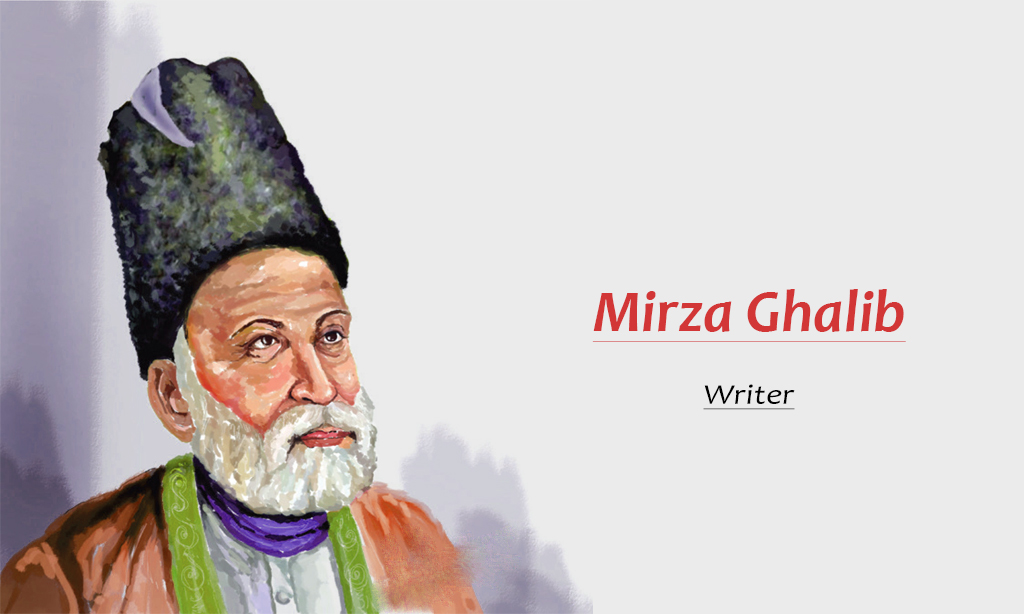Early Life:
Mirza Galib life journey ,he mawas born in Kala Mahal, Agra, into a family of Mughals who moved to Samarkand after the downfall of the Seljuk kings.
His paternal grandfather, Mirza Qoqan Baig, was a Suljuq Turk and descendant of Sultan Berkyaruq who had immigrated to India from Samarkand during the reign of Ahmad Shah.Having worked in Lahore, Delhi, and Jaipur, he received the sub-district of Pahasu and ultimately established his residence in Agra, UP, India.
Mirza Galib life journey had four sons and three daughters. Mirza Abullah Baig married Izzat-ul-Nisa Begam, an ethnic Kashmiri. .He initially served under the nawab of Lucknow before transitioning to the court of the nizam of Hyderabad in the Deccan region.
Subsequently, his upbringing was overseen by his uncle, Mirza Nasrullah Baig Khan.
Subsequently, his upbringing was overseen by his uncle, Mirza Nasrullah Baig Khan. However, in 1806, Nasrullah met his demise due to injuries sustained from falling off an elephant.
Married life:
Ghalib married Umrao Begam, daughter of Nawabs llahi Bakhsh. He soon moved to Delhi, along with his younger brother, Mirza Yousuf, who had developed schizophrenia at a young age and later died in Delhi during the chaos of 1857.
None of his seven children survived beyond infancy.Mirza Galib life journey After his marriage, he settled in Delhi. In one of his letters, he described his marriage as the second imprisonment after the initial confinement that was life itself. The idea that life is one continuous, painful struggle that can end only when life itself ends is a recurring theme in his poetry.
Career:
Mirza Ghalib began composing poetry at a young age. He spoke Urdu as his primary language at home, but Persian and Turkish were also part of the linguistic milieu. He received an education in Persian and Arabic at a young age .During the Ghalib period, the words “Hindi and Urdu” were synonyms. Ghalib, in his writing, used the Perso-Arabic script, which is employed for modern Urdu, and he often referred to his language as “Hindi.” .” One of his works was titled Ode-E-Hindi.
When Ghalib was 14 years old, a newly converted Muslim tourist from Iran (Abdus Samad, originally named Hormuzd, a Zoroastrian) came to Agra. He stayed at Ghalib’s home for two years, and she taught him Persian, Arabic, philosophy, and logic.
Although Ghalib valued Persian over Urdu, his fame rests on his writing in Urdu .Ali Haider Nazam Tabatabai of Hyderabad wrote the first elucidation, or sharh, on the Ghalib Ghazal compilation during the rule of the last Nizam of Hyderabad, according to Urdu scholars..
Before Ghalib, the ghazal was primarily an expression of anguished love, but Ghalib expressed philosophy, the travails, and mysteries of life and wrote ghazals on many other subjects, vastly expanding the scope of the ghazal.
A journey that changed Mirza Galib’s course of life:
Mirza Galib’s journey to Kolkata, or erstwhile Calcutta, made a huge difference in his literary journey. Mirza Galib came to the city of joy and fell in love. His love for Kolkata is depicted in one of his creations, safar-e-kolkattah, where he talks about his stay in his humble .During his stay in Kolkata, he situated Haveli No. 133 in the Simla Market area.
He used to write his verses in Urdu but started writing his poetry in Persian after his visit. He realized that the literary circle of Calcutta was very different from his known world.
During his stay in Kolkata, he attended many gatherings that were not courtly in nature, unlike in Delhi.Far more liberal and flexible in nature, these are imperative for any individual with a creative bent of mind .
Mirza Galib’s sojourn in Calcutta widened the horizons of his literary journey. He established himself as one of the most renowned poets in Calcutta and received both appreciation and criticism from the enlightened audience of the city. During this time,he penned two masnavis in Persian: Chirag-e-Dair( lamp of the temple) and Bad-e-Mukhalif (adverse winds).
His letter bears a testimony of his late love for Calcutta. In a letter he wrote to Mirza Ali Bakhsh Khan, he says how the city has stolen his heart and left him mesmerized. He referred to the city as a place that offered a remedy for everything except death and also praised the talented people of the city
Naat’s of Ghalib:
A large part of Ghalib’s poetry focuses on the naat, a poem in praise of Muhammad, which indicates that Ghalib was a devout Muslim.
In the form of a naat poem, Ghalib penned his “Abr-i-Gaugharbar” (Urdu, translating to “the jewel-carrying cloud”).
Additionally, he humbly acknowledged his own sinful nature, expressed unworthiness to address Muhammad, who was praised by God, and declared that, as a sinner, he should maintain silence before such greatness in a qasida of 101 verses dedicated to a naat.
Work:
Mirza Ghalib life journey he held Persian in high regard, and his knowledge of the language was a point of pride for him.
Ghalib dedicated the majority of his poetic compositions in Persian to numerous patron rulers, particularly in the form of qasidahs.
Ghalib also created Ghazala and Mathnaws in Persian.
His first published work in the language was a collection of poems titled May-Kana-e-arzu, released in 1845. He also created prose works, such as Panj Ahang, initially published in 1849.
Galib’s books:
Khatut-e-Galib
Diwan-e-Galib
Diwan-e-farci
Safina Galib
Bagh-e-Dudar
Urdu mula
Beyan-e-Galib
Galib ki Urdu nasar
Tafhim-e-Galib
Yadghar-e-Galib
Death:
Emperor Bahadur Shah Zafar II awarded him the titles Dabir-ul-Mulk and Najm-ud-Daulah in 1850. He died in New Delhi on February 15, 1896.They have turned the house where he lived into a memorial, hosting a permanent Ghalib exhibition.


